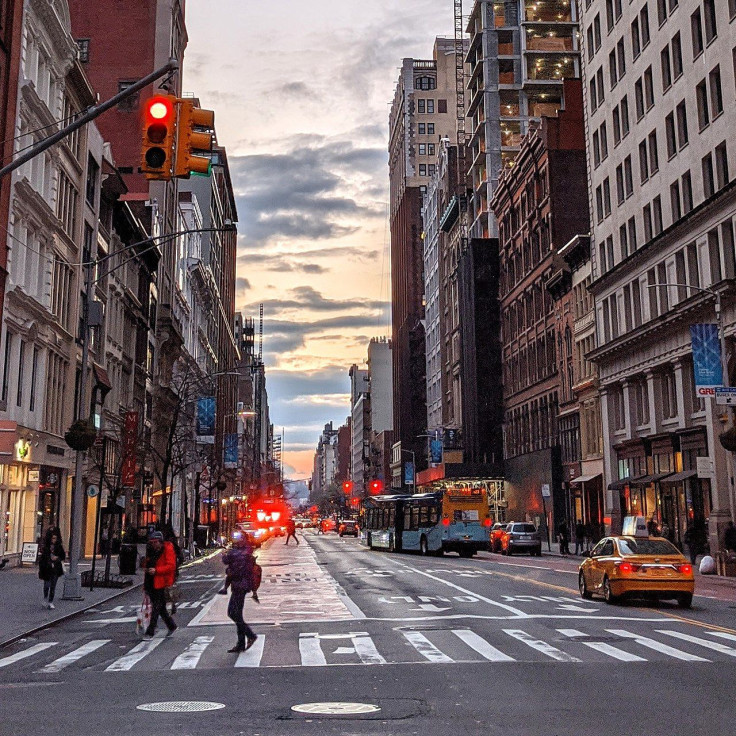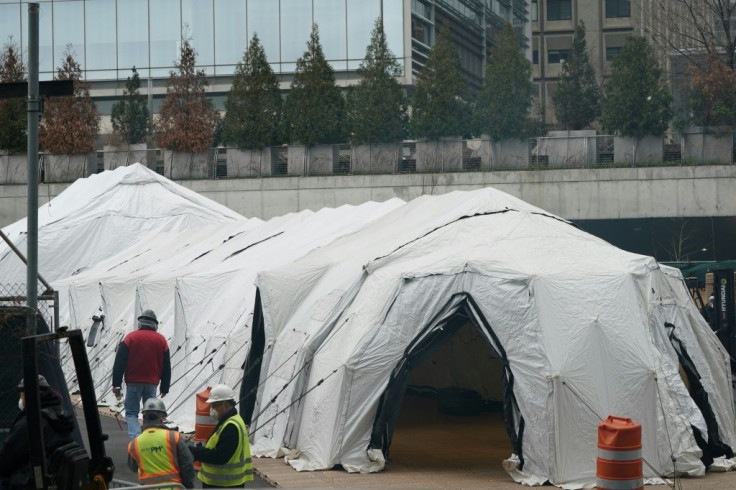Coronavirus USA Update: COVID-19 Cases Top 101,000 As Trump Invokes Defense Production Act
KEY POINTS
- USA is the first country to record more than 100,000 positive COVID-19 cases
- Trump signs the $2 trillion stimulus package to help Americans
- The president invokes the Defense Production Act to ramp up production of ventilators
The number of confirmed coronavirus cases in the U.S. blew past the 101,000 mark Friday, giving America the unfortunate distinction of the nation with the most number of COVID-19 infections across the world.
On Friday, data compiled by the John Hopkins University showed the number of coronavirus infections across the globe nearing 600,000. The U.S. accounted for nearly 105,000 of those cases, with more than 1,700 deaths. These grim numbers are expected to rapidly increase in the coming days as testing expands across America. Italy, with more than 9,000 deaths and 86,000 confirmed cases, was second. China, the original center of the pandemic, reported 54 new cases Friday -- all of them were "imported," meaning they were brought into the country by those coming from abroad.
U.S. health officials said that the actual number of cases may be even higher but there are not enough testing kits to confirm the extent of the spread of the disease. According to White House coronavirus response head Dr. Deborah Birx, the Centers for Disease Control and Prevention (CDC) has conducted 370,000 tests so far.

Four states have been the hardest hit since the first reported COVID-19 case in the U.S. -- New York (44,635 cases), New Jersey (8,825), Washington (3,723) and California (4,533). New York Governor Andrew Cuomo said in a press conference that the state will open additional treatment centers and was stockpiling medical supplies including ventilators. He also said the "apex of coronavirus cases" in the state will come within 21 days -- an indication of the enormity of the crisis facing the state.
"That number is going to continue to go up, and that is the worst news that I could possibly tell the people of the state of New York,” Cuomo said, adding that school closures shall be extend until April 15.
California, which fears it could be the next New York, is still testing fewer patients compared to New York. So far, 91 deaths have been reported in the Golden State. The Californians are taking it day by day and are trying to emulate New York's efforts in addressing the needs of the patients.
LA County Department of Public Health director Barbara Ferrer fears that as much as a million people could be COVID-19 positive. San Francisco Mayor London Breed said that they will likely need an additional 1,500 ventilators and 5,000 hospital beds.
The crisis is spreading fast and the number of confirmed infections is rapidly increasing in cities like Detroit, Chicago and New Orleans. Hospitals in these emerging hotspots are preparing for the coming spike while convention centers are also being converted into medical facilities to accommodate the expected surge in patients.
Still, the day also offered streaks of positive news amid all the gloom and panic as the nation's political leadership, which has been accused of dither and delay in bringing help to struggling Americans, finally got its act together.
First, President Trump invoked the Defense Production Act to order General Motors to ramp up the production of ventilators needed for critical COVID-19 patients.
GM had said it would retool its Kokomo, Indiana, plant to produce ventilators with technology from Ventec Life Systems. The company said it would put several hundred million dollars upfront to get production started but the effort would cost more than $1 billion.
"GM was wasting time," the White House said in a statement. "Today's action will help ensure the quick production of ventilators that will save American lives."
The president said invoking the act could bring on stream 100,000 more ventilators desperately needed by hospitals. However, it is not clear how soon those who become available as the nation grapples with a tsunami of coronavirus infections. The Society of Critical Care Medicine in New York has estimated the U.S. will need as many as 1 million respirators to handle the pandemic. Currently the U.S. has 160,000 to 200,000.

Trump signs $2 trillion stimulus package
The President also signed the $2 trillion stimulus package that will put cash into Americans' hands and offer relief for those struggling to pay bills and debt amid the unprecedented lockdown. The House approved the stimulus package by voice vote Friday, after shutting down the request for a roll call vote from Rep. Thomas Massie (R-Ky). The run-up to the vote was not smooth, with lawmakers and the White House spending days negotiating details of what was to be included in the bill even as the crisis worsened.
Under the stimulus package, legal and eligible residents will receive a one-time check payment of $1,200 (individual taxpayers) or $2,400 (married joint taxpayers).
Treasury Secretary Steven Mnuchin said, in an interview on CNBC, that taxpayers using bank accounts for IRS refunds may receive direct deposits within three weeks. Those without bank accounts will receive the check in the mail based on their IRS address on file. Mailed checks will take longer than direct deposits.
The stimulus package will expand the current unemployment benefits. Furloughed workers are also eligible to receive checks. The IRS has provided a Coronavirus Tax Relief page for updates about the stimulus payment.
With #IRSDirectDeposit, you can split your tax refund into up to three financial accounts, including a bank and part can even be used to buy U.S. Series I Savings Bonds. https://t.co/8dF7SHWYze
— IRSnews (@IRSnews) March 28, 2020
Still the shortcomings of America's response to the coronavirus pandemic, despite the lead time offered by China's struggles in Wuhan where the disease first appeared, were evident. The nations still is struggling to get enough testing kits, ventilators and intensive care beds for those sick of the virus.
President Trump has been widely blamed for downplaying the seriousness of the pandemic despite intelligence reports about the real situation in China. But Democrats have also been culpable as they delayed the passage of the stimulus bill as individuals and businesses struggled. Their principled objections about businesses trying to benefit from the stimulus money have rung hollow against their record of failing to hold the feet of big businesses and Wall Street to the fire in the aftermath of the 2008 financial crisis.

On Friday, at a press conference, President Trump tried to take a "glass half full" view of his administration's response. When asked by ABC News’ Jonathan Karl for assurance that everyone who needs a ventilator would get one, the President said, “I think we’re in really good shape. This is a pandemic, the likes of which nobody’s seen before.” But when the reporter pressed further, Trump fired back, "“Look, don’t be a cutie pie, okay? Nobody’s done what we’ve been able to do.”
Except that those comments come against a backdrop of avoidable delays that have now led to a desperate struggle to get enough ventilators and test kits available to everyone, on time, so lives can be saved.
© Copyright IBTimes 2024. All rights reserved.











